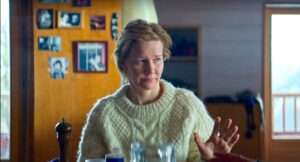Making a film about the Holocaust is always problematic. How do you create something that properly represents or explains an atrocity so enormous it defies comprehension? The Nazis systematically exterminated nearly all the Jews of Europe. More than a million were killed at just one complex, Auschwitz-Birkenau, in what is now Poland, through slave labor, mass shootings, and, with industrial efficiency, poison gas. The murder of one person is a tragedy. How does a filmmaker do justice to murder on such a mind-bending scale?
In 1956, French auteur Alain Resnais directed a 32-minute documentary, Night and Fog, using spiritual, poetic language in the narration and shocking, obscene footage of the human toll at the camps. François Truffaut dubbed it “the greatest film ever made,” and I saw it in class as a public-school student in Fair Lawn, N.J.
In 1978, NBC presented an eight-hour miniseries, Holocaust, featuring Meryl Streep, that chronicled the destiny of a German Jewish family during the Third Reich. It was a highly rated event but not much of an artistic success.
There have been several films in the years since that have dealt with camp prisoners or Nazi history. The most celebrated is Steven Spielberg’s 1993 blockbuster, Schindler’s List, which depicts a gentile businessman’s heroic efforts to save Jews by keeping them employed in a munitions factory. That movie offers a brilliant sequence on the emptying of the Krakow ghetto, but its Auschwitz scenes are not much of an improvement over the NBC miniseries.
To date, the best attempt to capture the magnitude of the Holocaust’s importance is Claude Lanzmann’s nine-and-a-half-hour documentary, Shoah, released in 1985. Lanzmann employed no historical footage: he simply filmed the locations of the Holocaust, ghostly and chilling, and interviewed survivors, witnesses, even perpetrators. It is a monumental film, never pandering and sentimental like Schindler’s List. Instead, it deals with its insuperable subject matter in a sober, deliberate, and relentless way, allowing us to absorb its overwhelming truths over time.
Now there’s a new film about the Holocaust playing only in theaters: The Zone of Interest. It’s directed by Jonathan Glazer, a Brit with an impressive résumé (Under the Skin; Sexy Beast), and is very loosely adapted from a Martin Amis novel. The spare storyline follows the household routine of real-life Auschwitz commandant Rudolf Höss (Christian Friedel) and his family in 1943, at a time when the camp is being readied for the arrival and extermination of a half-million Hungarian Jews. Though Amis’s novel imagines events and characters within and outside the work and death camps, Glazer mostly restricts his film to the eerily rustic residence of the commandant, just beyond the camp walls.

Höss’s wife, Hedwig (Sandra Hüller), tends the grounds, servants, and their three children like a Nazi Marie Antoinette, hosting parties and snipping flowers in her garden. There are some dreamy infrared sequences of a young girl wandering around the work camp at night, and Höss, at one point, is transferred to another job, but The Zone of Interest focuses intently on the quotidian life of the SS officer’s family, while screams and gunshots and plumes of crematory smoke emerge hazily in the background. It’s all creepy to the max but not much more than a one-note meditation on what Hannah Arendt called the “banality of evil.” Manohla Dargis of the New York Times judged the movie to be “vacuous,” but The Zone of Interest is up for Best Picture and other Oscars, so it must have impressed the Hollywood establishment.
Another film that’s up for Best Picture, Past Lives, has nothing to do with the Holocaust or any kind of evil. It’s a first feature for writer-director Celine Song, the unabashedly romantic story of a childhood love enduring the dislocations of the immigrant experience and two decades of living apart.

We first meet the film’s main character, Nora, as a pre-adolescent in Seoul, South Korea, where she’s known as Seung Ah Moon and her best chum and academic rival is Hae Sung, a boy who clearly has a crush on her. Nora’s parents are a writer and filmmaker, and they decide to emigrate with their two young girls to Canada. Nora doesn’t tell Hae Sung she’s moving. And then she’s gone.
Cut to 12 years later, when Nora, now played by the marvelous Greta Lee, is a budding writer living in New York City and about to embark on a residency at a Yaddo-like retreat. Before she goes, she receives a message from Hae Sung (Teo Yoo), now an engineering student in Korea. They reconnect in video chats, but before a romance can bloom, Nora ends the communication. She wants to focus on her career.
Another 12 years later. Nora has married a Jewish writer (John Magaro) whom she met at the retreat, and they live together contentedly in New York. Hae Sung, who lives at home with his parents, takes a vacation in New York City so he can see Nora again. What happens then is beautifully and realistically resolved — it’s as touching as a grown-up love story can be.
Nora is as forthright and willful as Hae Sung is restrained and considerate; she calls him “very Korean.” Both Lee and Yoo flesh out their unusually grounded characters with every word and movement. What holds them back are the contingencies of real relationships — there are no big secrets or twists here.
Past Lives is an extraordinary debut. Although Song has said that the movie is based on her own life story, it’s wiser and humbler than most immigrant tales. And it’s streaming on most services. Do yourself a favor and see it.
Finally, another film that’s nominated for Best Picture and available for streaming is Anatomy of a Fall, co-written and directed by French filmmaker Justine Triet (whose nomination for Best Director caused fans of Barbie’s snubbed Greta Gerwig to scratch their heads). The title appears to be an homage to Otto Preminger’s classic Anatomy of a Murder, because Triet has created an equally unsettling trial drama in which there’s a good deal of uncertainty about the guilt of the accused. In contrast to Preminger’s black-and-white thriller, however, Triet’s film is thoroughly contemporary, cosmopolitan, and psychologically nuanced. The movie’s title is especially apt because the plot hinges on whether the victim’s death was actually a murder.

It takes place in the French Alps during winter. Sandra Voyter (Sandra Hüller) is a German writer who lives with her husband, Samuel, a less accomplished French writer, and their blind young son, Daniel (Milo Machado Graner). Suddenly, Samuel falls from the third-floor attic of their chalet and is found dead. Why did he fall? Prosecutors believe Sandra hit him on the head and threw him out. The defense wants you to believe it’s suicide.
The story is rich with telling details: that Daniel is blind due to an accident that happened on his father’s watch; that Samuel had already attempted suicide; that Samuel and Sandra had had a heated fight the night before; and, finally, that Daniel and his seeing-eye dog, Snoop (awarded the “Palm Dog” at Cannes), found Samuel’s corpse, and Daniel’s testimony will be key at his mother’s trial.
Hüller gives a dazzling performance as Sandra — high-strung yet soft-spoken, cautious yet brutally honest, multilingual and openly bisexual. (She is nominated for Best Actress as well.) Milo Machado Graner as Daniel is astoundingly good. And Triet has directed with a remarkably sure hand: pushing moments of tension without too much visible manipulation. Anatomy of a Fall is a shrewd update of a classic genre movie. I’ll take it over Barbie any day.
